Featured Comment
“We tried this recipe last night because it has been a hot minute since my boyfriend and I have had a good yakisoba and I have to say, everything about it was fantastic! For sure a new favorite in our home. Thank you for sharing this!“
– Ashley
When I first shared this Yakisoba recipe in December 2020, I thought it was perfect. It was easy, accessible, and authentic. I had no idea that a chance discovery in January 2025 would change everything.
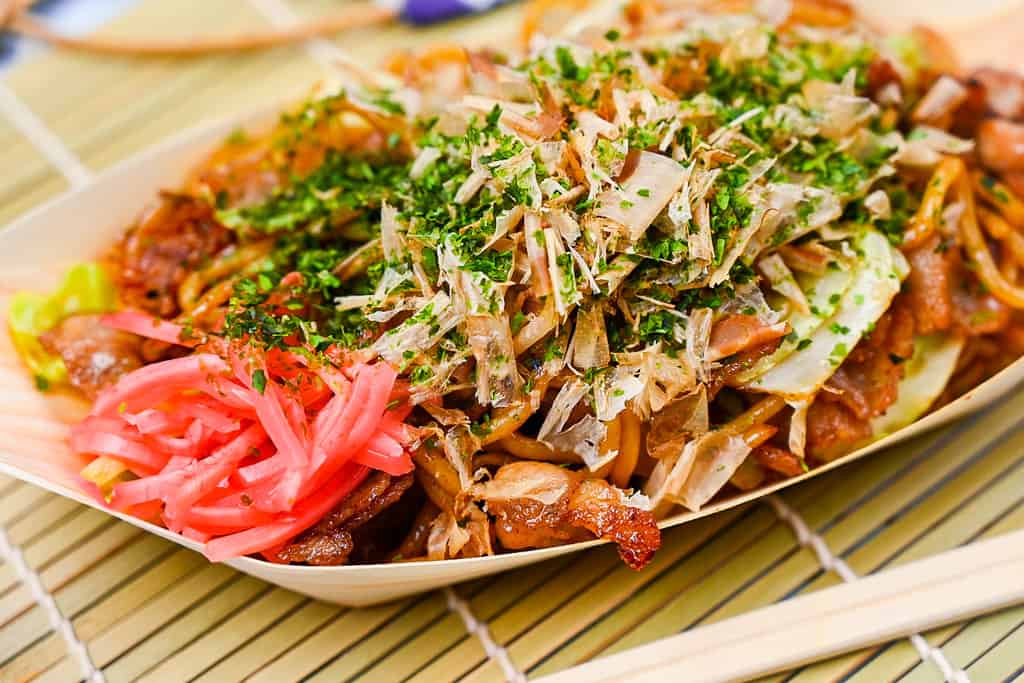
This recipe has been a fan favorite both on here and social media for the past five years. Why the changes now? Because I stumbled upon an absolute game-changer. And yes, it’s in the sauce.
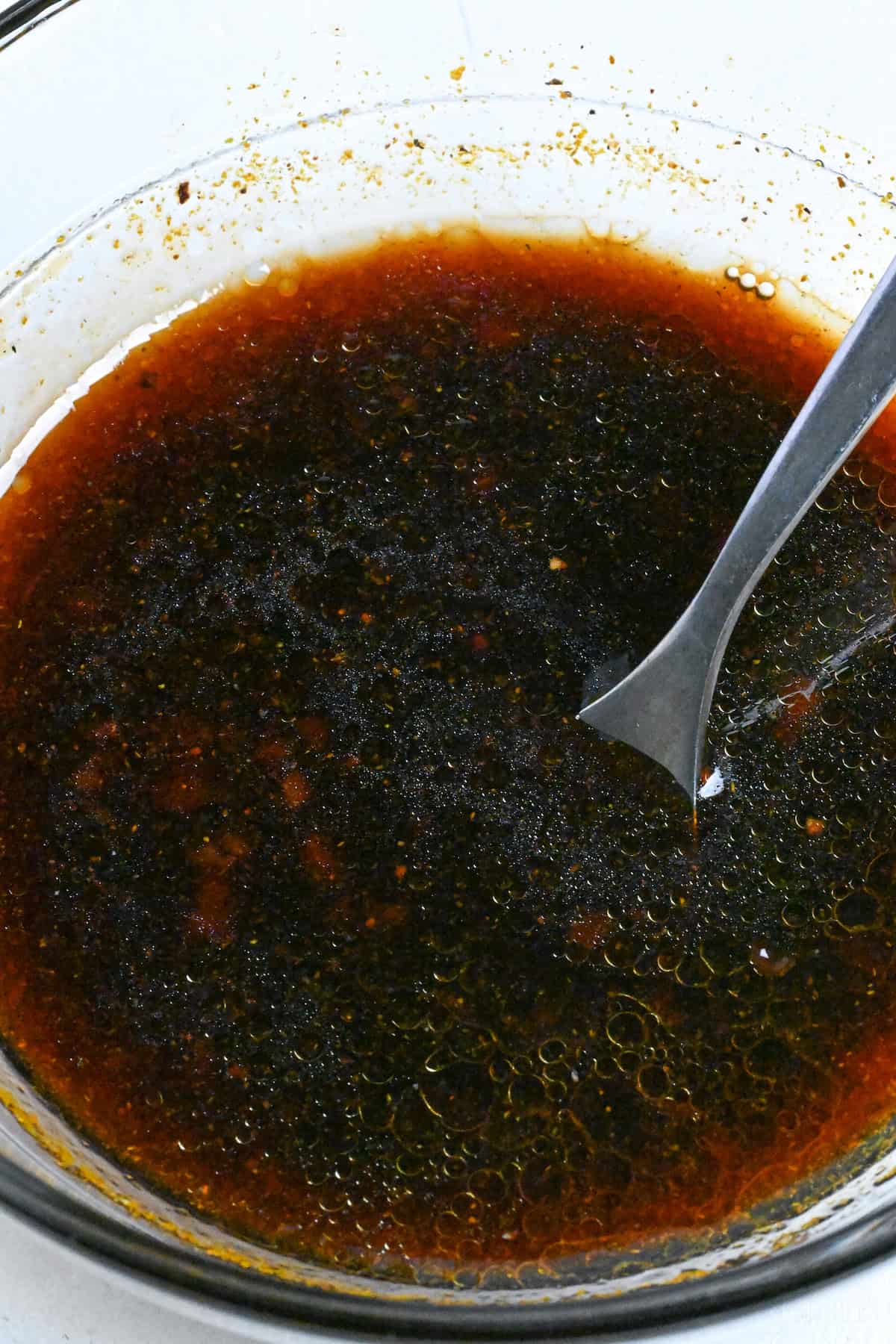
I can say with confidence that this recipe has become at least twice as delicious as the original. All thanks to adding just one ingredient.
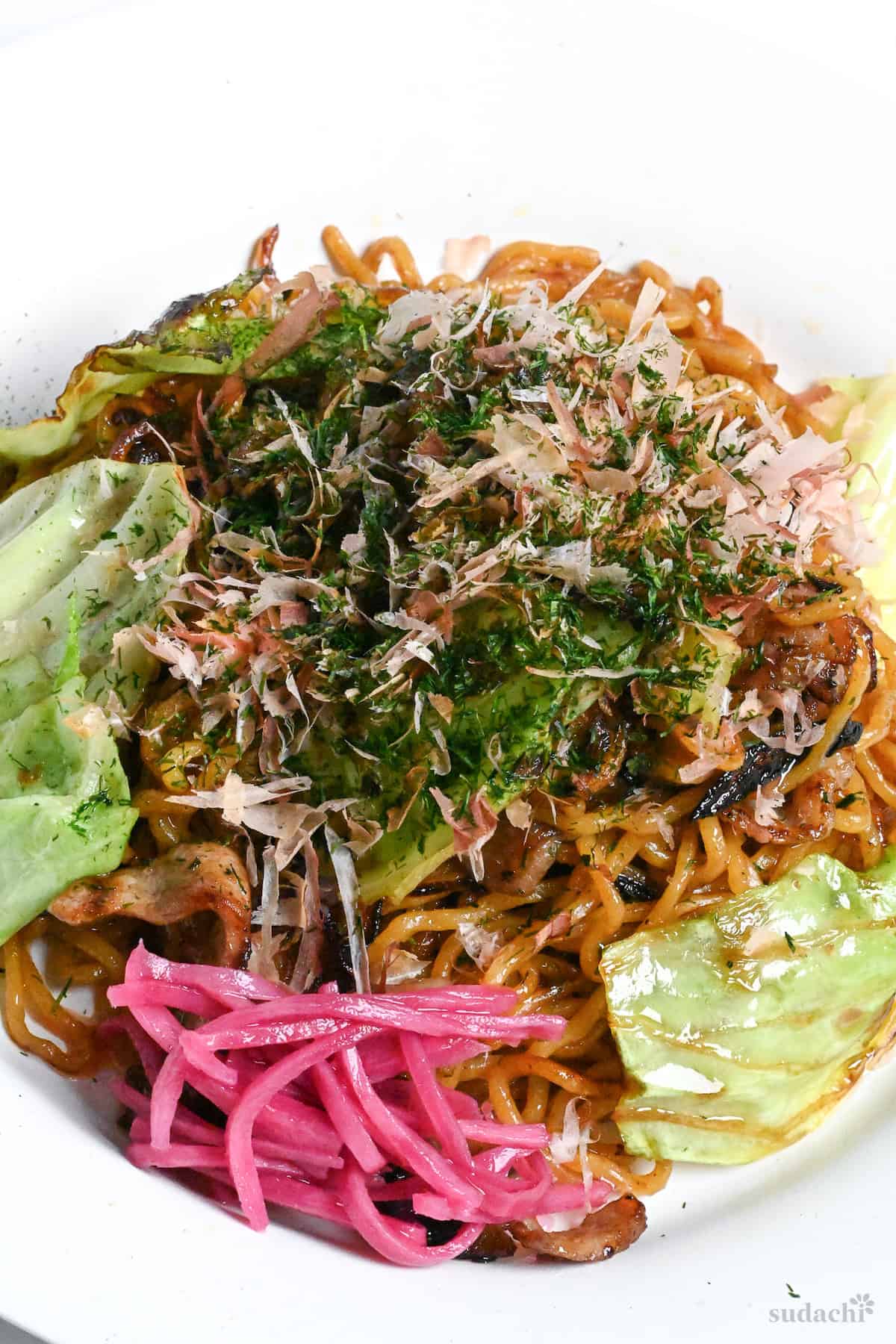
Want to know the secret ingredient that made my popular recipe even better? Keep reading to discover what makes it from great to unforgettable!
What is Yakisoba?
The smell of yakisoba (焼きそば) sizzling on teppan griddles at Japanese festivals is hard to miss. It’s a sensory experience that instantly transports you to the festival.
That distinctive fragrance (sweet, savory, and slightly tangy) cuts through the festival air, accompanied by the rhythmic clanking of metal spatulas against the hot surface. Close your eyes, and you’re there again.
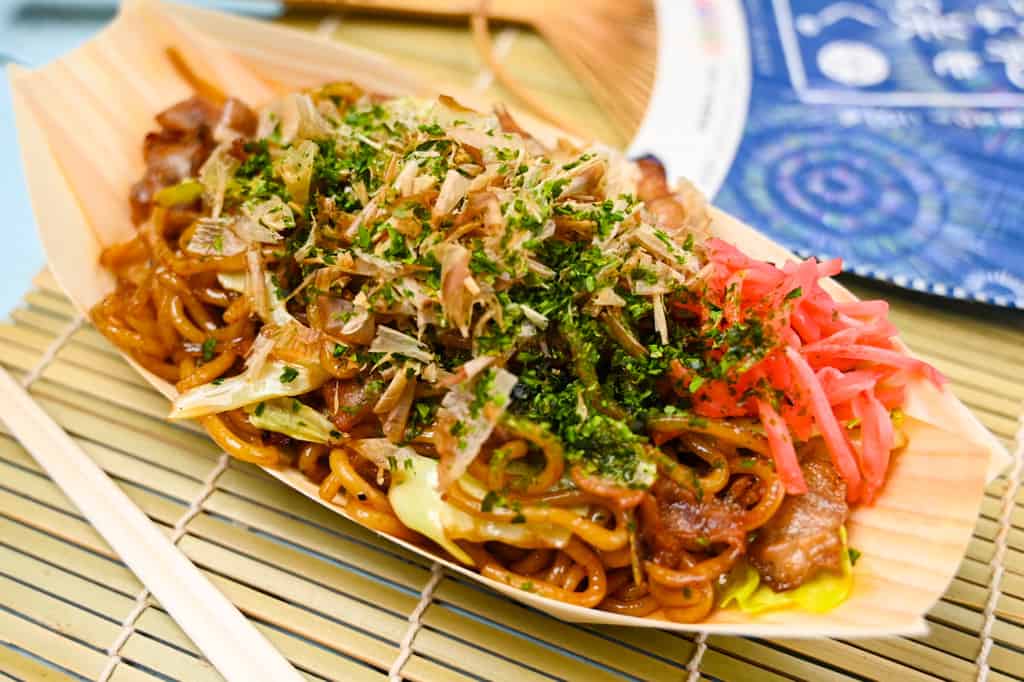
This beloved Japanese street food, with its Chinese chow mein influence, brings together the perfect combination of chewy noodles, tender pork, crisp vegetables, and that signature tangy yakisoba sauce that ties everything together.
In this recipe, I’ll guide you through creating yakisoba exactly as you remember it. From crafting the perfect sauce from scratch to achieving that ideal texture. The result is going to be even better than what many street vendors.
Ingredients & Substitution Ideas
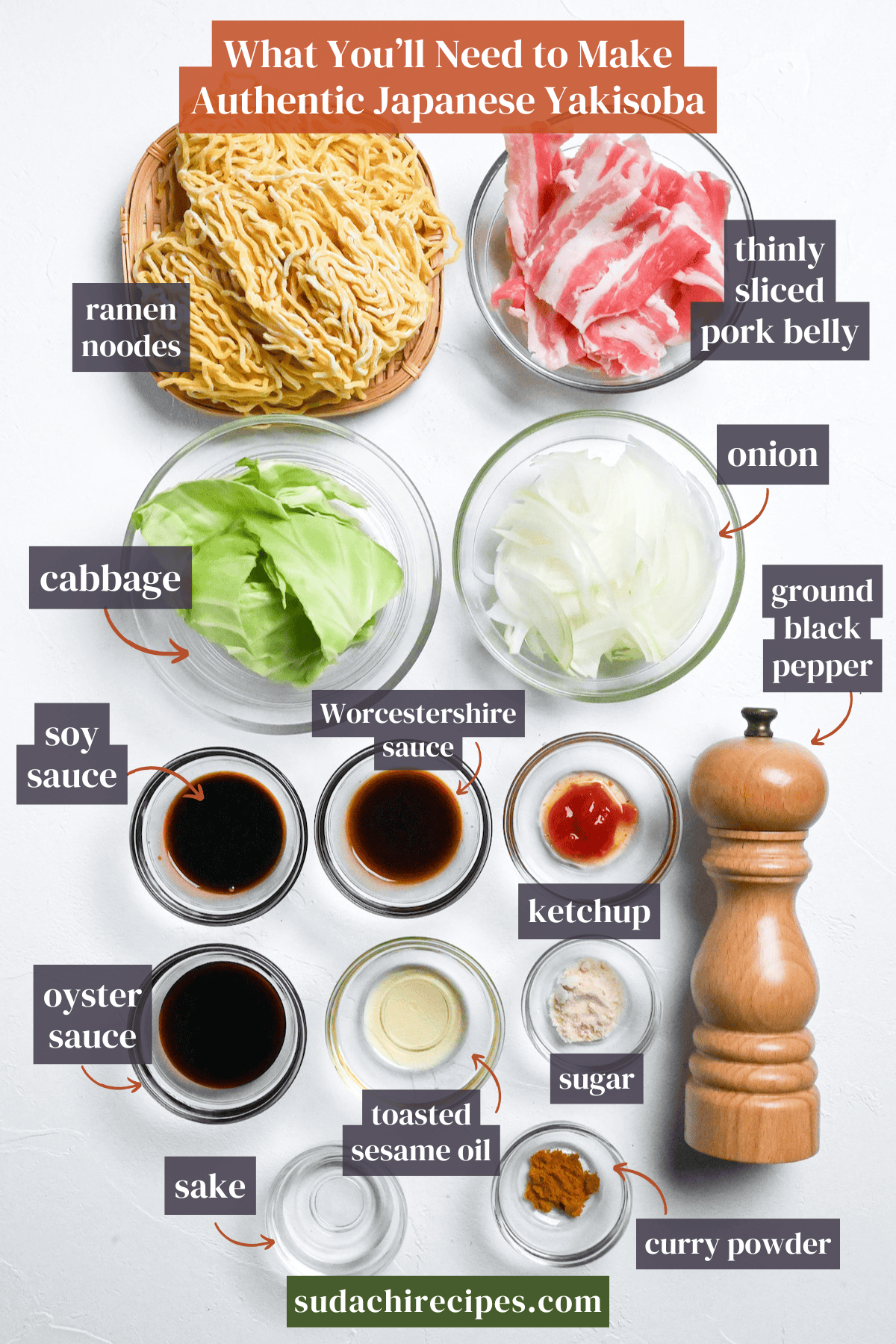
- Thinly sliced pork belly: I recommend using thinly sliced pork belly for its rich flavor and tender texture, as the fat renders beautifully during cooking. If you’re in the mood for variety, feel free to experiment with other pork cuts, chicken, or beef. Just be sure to adjust the cooking time accordingly.
- Yellow onion: Thinly sliced. While yellow onions are the go-to in Japan, white onions can be a great substitute if needed.
- Green cabbage: This is a great option if you’re looking for a classic, authentic flavor. But feel free to explore other cabbage varieties that suit your taste or what’s available at your local market.
- Ramen noodles: We will hard-boil ramen noodles. You can also make your own homemade ramen noodles if you want! If you struggle to find quality noodles, consider using my Spaghetti Ramen Hack.
- Yakisoba sauce: Mixture of oyster sauce, soy sauce, Worcestershire sauce, tomato ketchup, sake, sugar, and toasted sesame oil.
- Curry powder mix: This is the secret ingredient I’ve been teasing, curry powder! While I use a Japanese-style curry powder mix, the goal isn’t to make the sauce curry-flavored. Instead, it adds a subtle layer of spice and complexity that enhances the overall flavor without overpowering the dish. So, you can use any curry powder mix you already have in your pantry!
- Toppings: I used red pickled ginger (benishoga), bonito flakes (katsuobushi), and aonori powder.
Alternative Ingredient Ideas
Like all stir-fry dishes, yakisoba is wonderfully versatile. Every household has its own favorite combination of ingredients. While my recipe uses a specific set of ingredients, here are some popular alternatives you might want to try. Feel free to tweak the recipe to make it your own!
Just remember one important tip: avoid adding too many water-rich vegetables and too many vegetables in general, as they can make your dish too soggy.
- Carrots: You’ll want to use about a quarter to half of a medium-sized, julienned carrot. If you want crunch, you can go for roughly cut or sliced instead. Try to add the carrot at the same time as the onion to give it enough cooking time.
- Beansprouts: You can add some nice crunch by using between 50g and 100g (or about half to a full cup) of washed beansprouts. Try adding them at the end and stir fry about 1-2 mins. Make sure you don’t add and cook too much, as they are very watery.
- Bell Peppers: You’ll want to use about 50g, which is about a quarter of a large pepper, cut into thin strips. Add these at the same time as the onion.
- Mushrooms: Any variety that’s usually used in stir-fry dishes should work. Try to use somewhere between 50g and 100g, and if they need to be sliced, go for it. Like the previous vegetables, mushrooms should be added at the same time as the onion.
- Sunny-side-up eggs: For an extra satisfying meal, try topping your finished yakisoba with a sunny-side-up egg! The runny yolk adds richness when it mixes with the noodles.
Visual Walkthrough & Tips
Here are my step-by-step instructions for how to make the best yakisoba at home. For ingredient quantities and simplified instructions, scroll down for the Printable Recipe Card below.
If you prefer to watch the process in action, check out my YouTube video of this recipe for a complete visual walkthrough!
Mix all the sauce ingredients in a small bowl and set them aside.
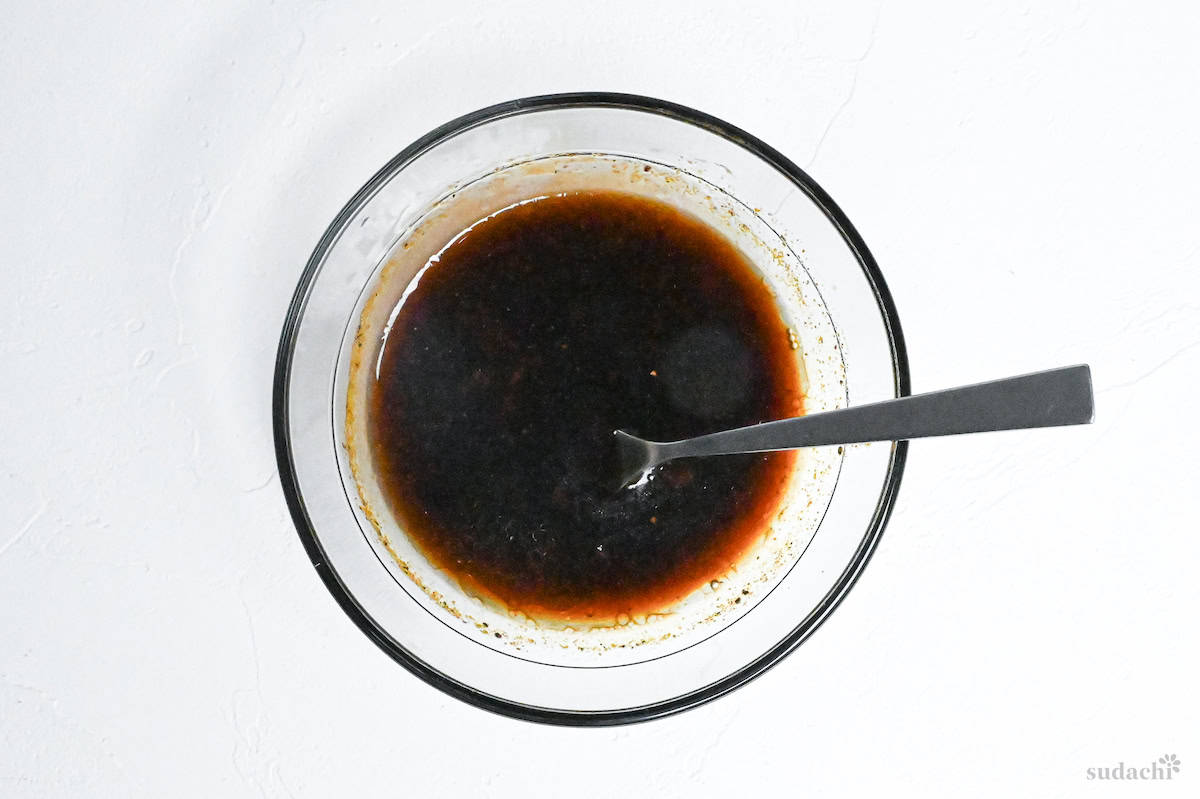
Fill a large pot with water and start bringing it to a boil. This way of doing things is a lot faster and makes sure everything is ready when you need it.
Using plenty of water helps keep the noodles hot when you add them, so they don’t clump together and end up mushy.
Heat up a frying pan over medium heat and add some neutral cooking oil like canola or rice bran oil. Throw in the thinly sliced pork belly and onions, and season with salt and pepper. By the way, I recommend using a non-stick frying pan. I’ll explain why later.
At this point, you can add optional ingredients like carrots, bell peppers, or mushrooms. Just remember to use them sparingly. Adding too many vegetables can throw off the balance of flavors!
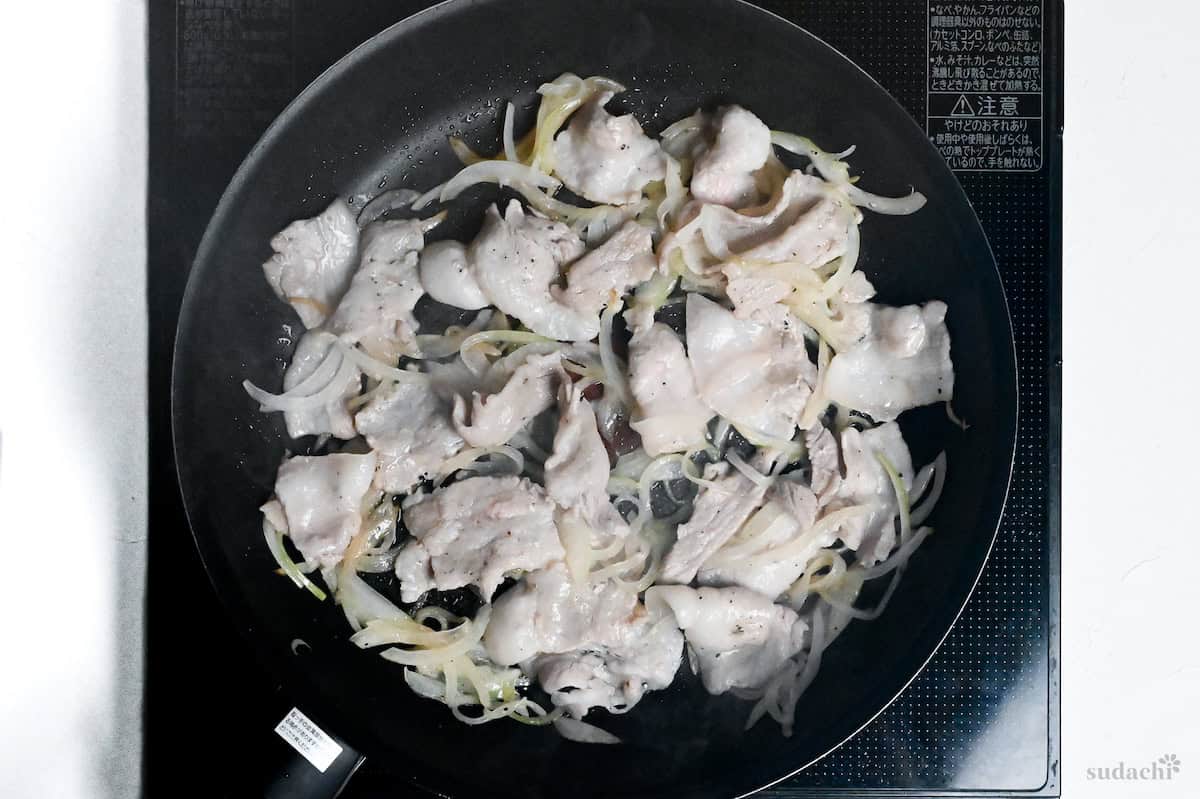
Cook it until the pork becomes crispy and starts to render its fat, which should take about 5 minutes. The fat that’s rendered while cooking is what’ll give the final dish its great flavor, so don’t drain it.
The onion in this recipe plays a subtle but crucial role. It’s meant to add depth in the background rather than steal the show. To achieve this, slice it very thin so it almost melts into the dish. Think of it as a supporting actor that enhances the overall flavor without being noticeable!
When you’re done, put the pork and onions on a plate and leave the fat in the pan.
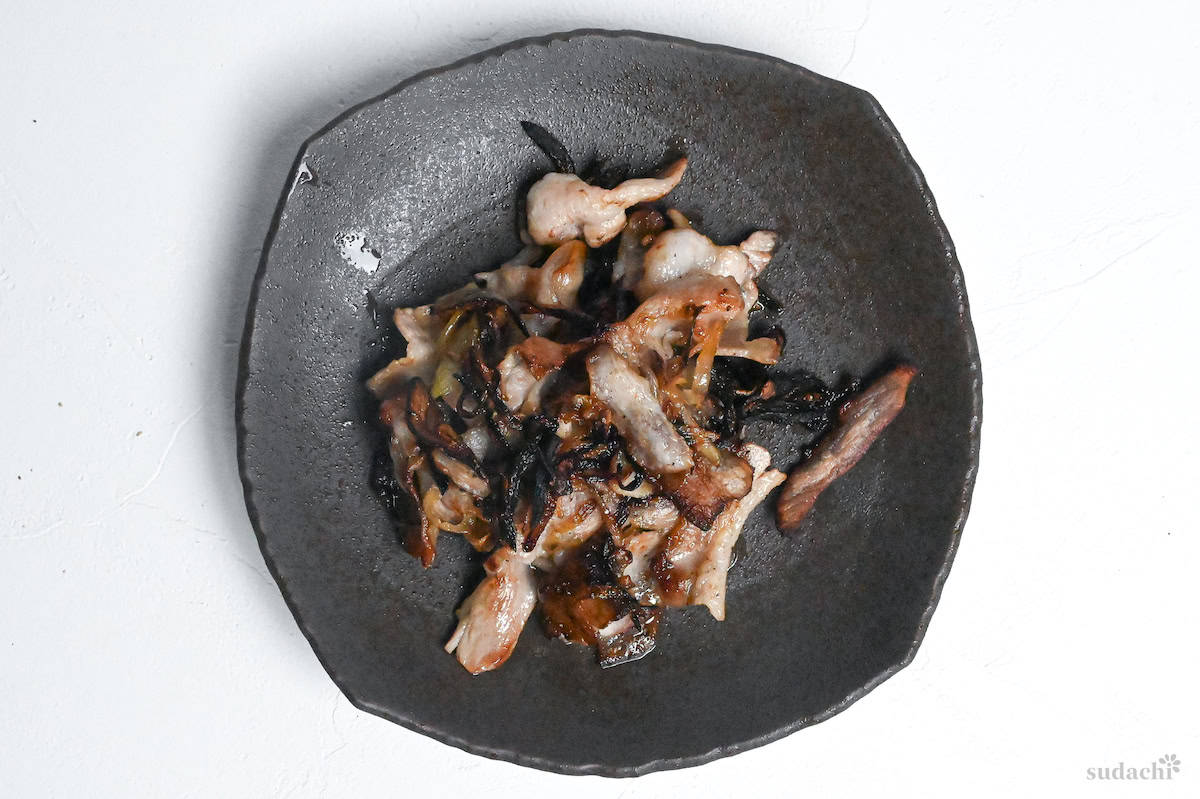
You might think it’s overcooked, but I recommend cooking the pork belly thoroughly for two reasons: it allows the fat to render properly and creates deliciously crispy pieces that enhance the yakisoba’s overall texture.
Cook ramen noodles a little bit less than what it says on the package.
A good rule of thumb is to subtract 10 seconds from every minute of the recommended cooking time. So, if it says 1 minute, cook them for 50 seconds; if it says 5 minutes, aim for 4 minutes and 10 seconds.
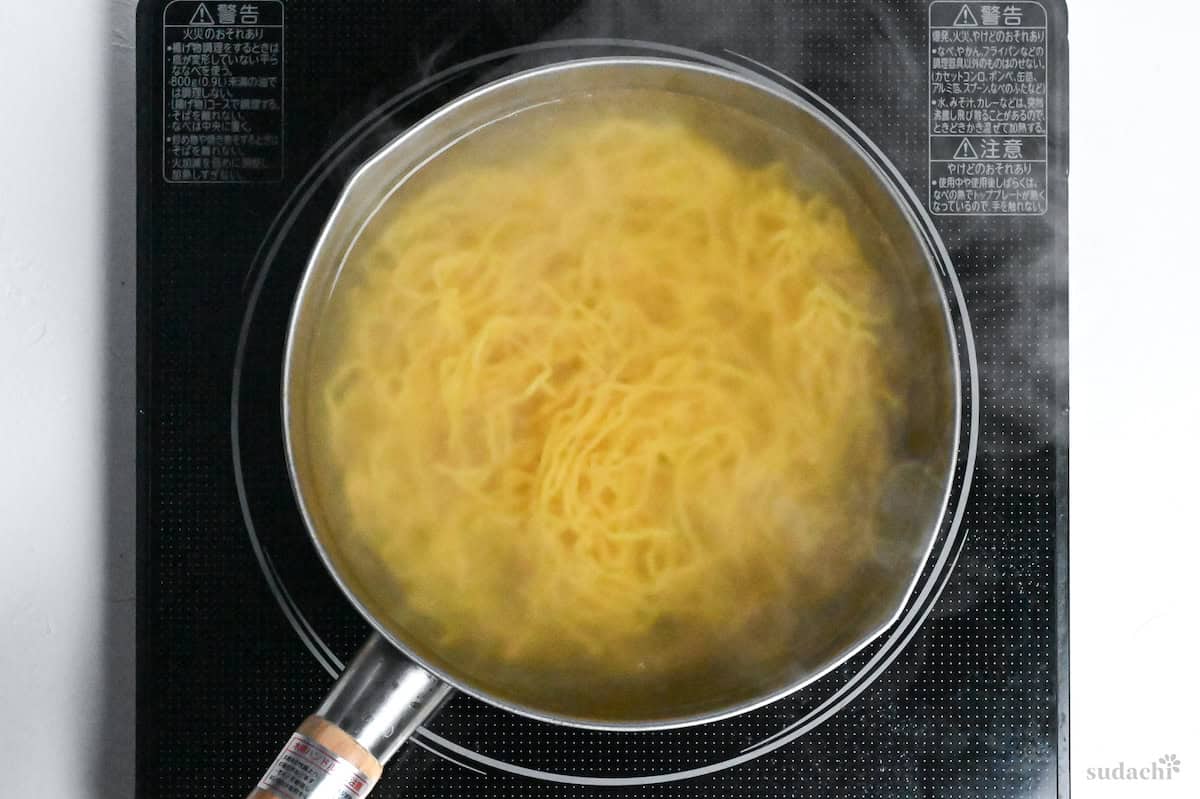
If you plan to make this yakisoba from fresh noodles instead of pre-steamed yakisoba noodles, I’d recommend making your own ramen noodles or using my spaghetti hack. I wouldn’t recommend using instant cup noodles.
Drain and immediately rinse under cold water to get rid of excess starch and stop them from cooking further. This will prevent clumping during stir-frying.
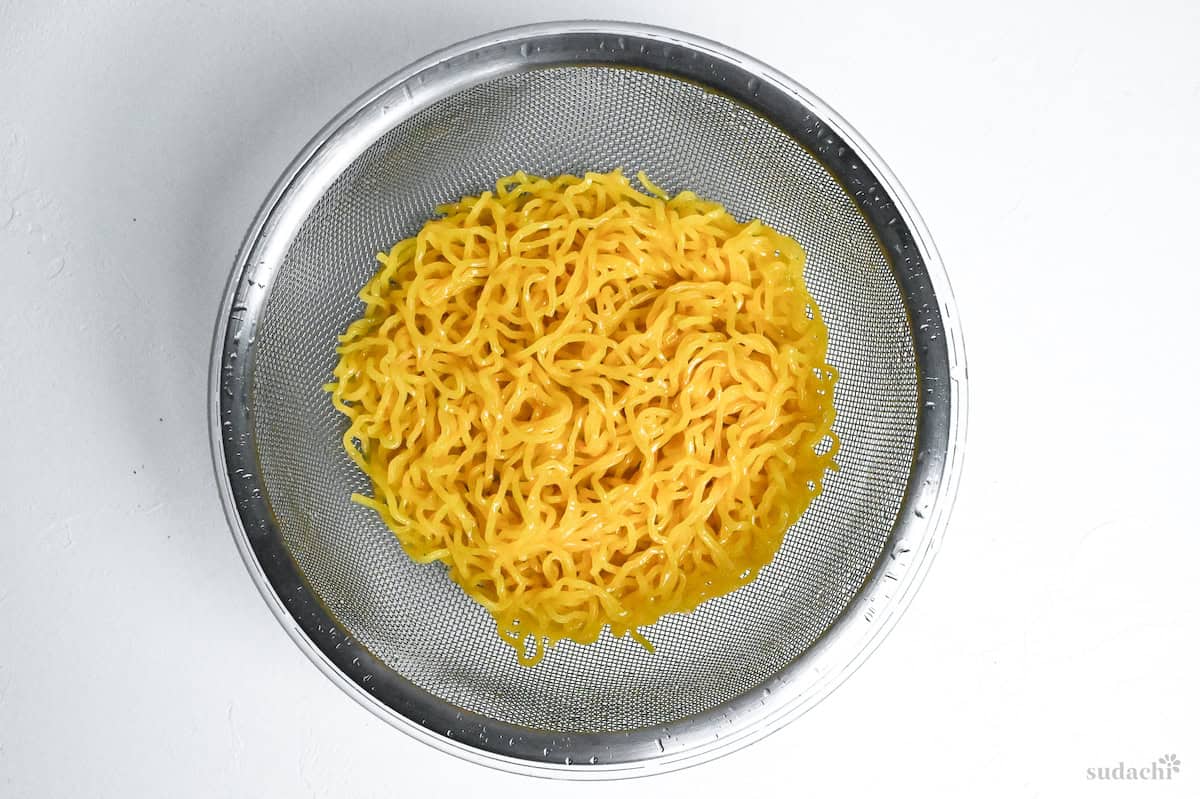
Then, after you drain them, put them in a bowl and toss them with a bit of cooking oil.
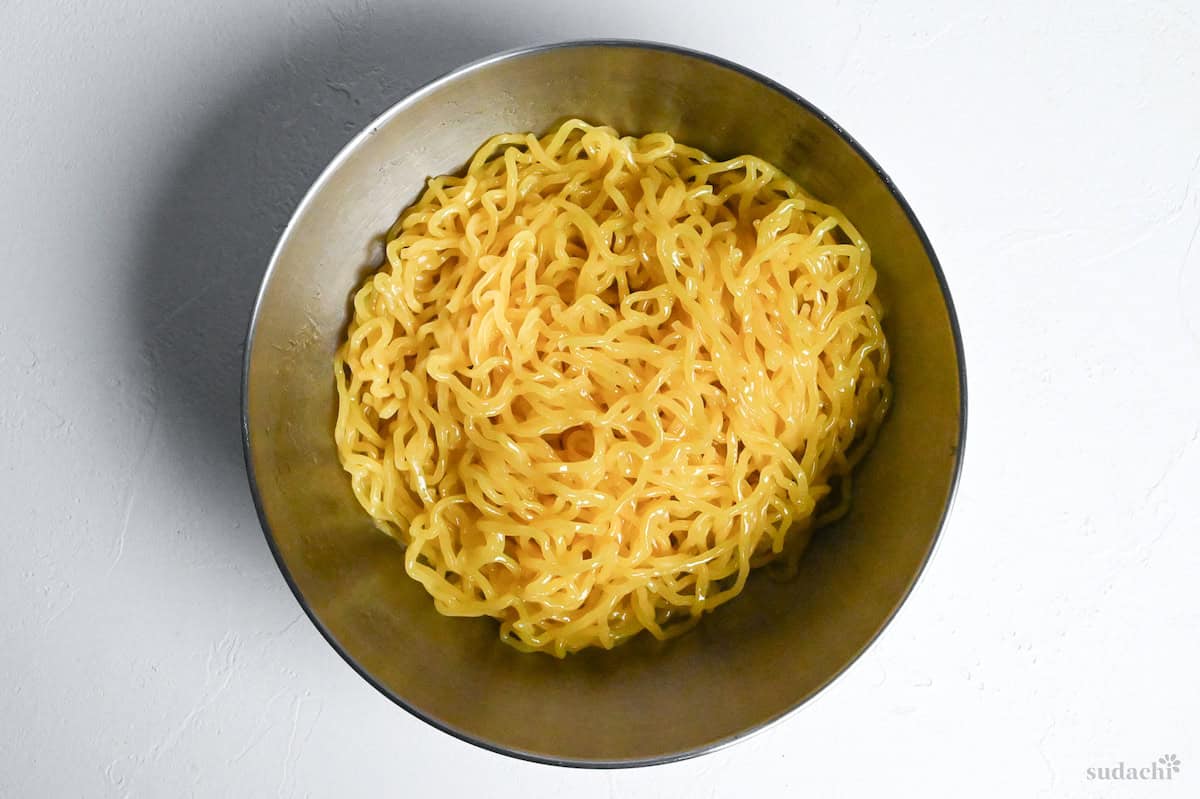
This coating keeps the noodles from getting soggy and clamping up.
In Japan, you can find special yakisoba noodles that you can use right out of the package.
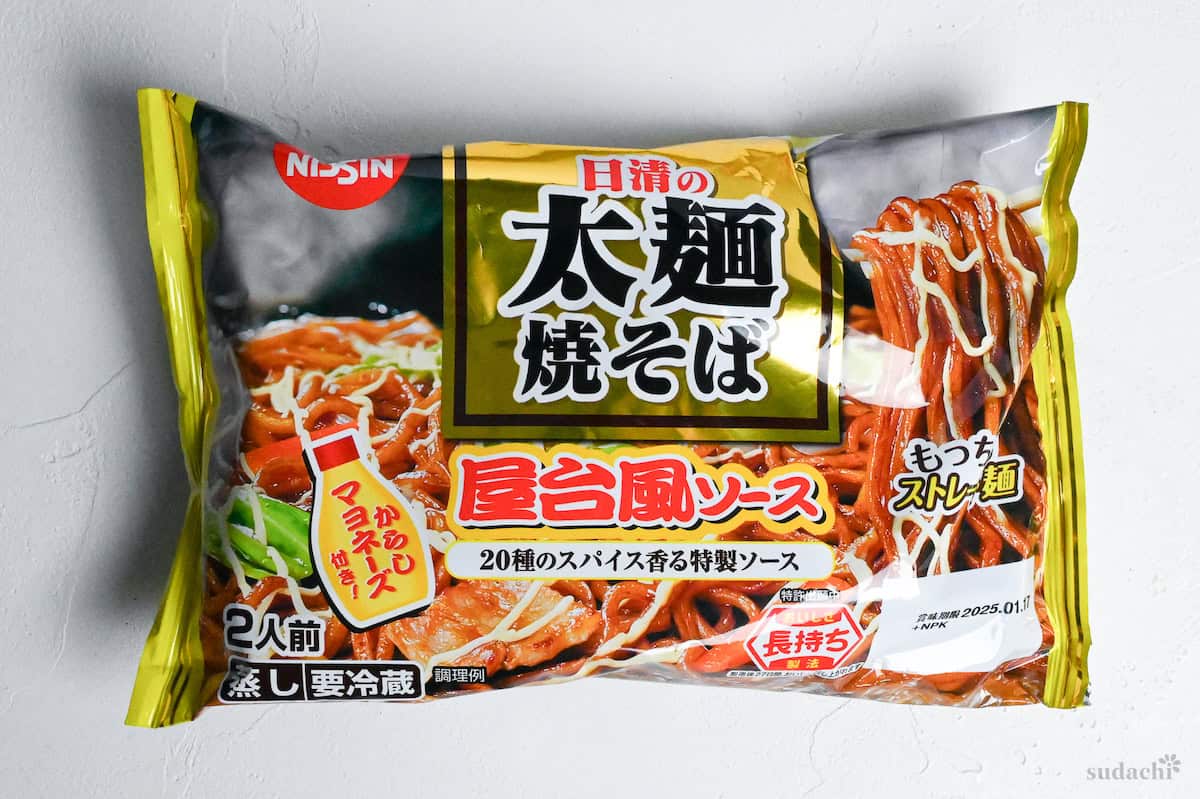
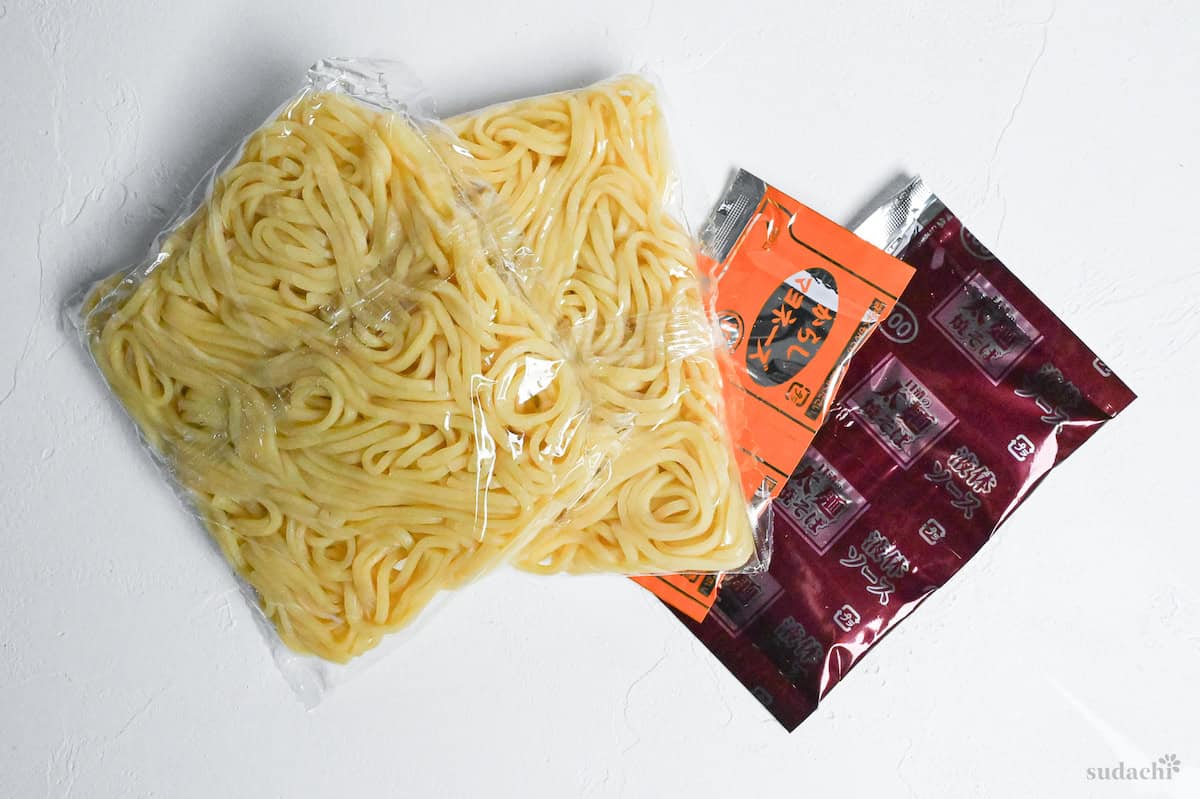
These noodles come pre-steamed and coated in oil. This means if you use these special noodles, there’s no need to boil them!
Return the pan with reserved pork fat to medium-high heat. Add the coated noodles and fry until they begin to brown and become slightly crispy.
I think the best yakisoba has that beautifully greasy finish, but you can always dab away the excess oil with a paper towel if you prefer a lighter version.
If you’re using other cuts of pork or different proteins instead of pork belly, keep in mind that they won’t render as much fat during cooking. In that case, you’ll need to add some cooking oil at this stage to compensate for the missing rendered fat.
By the way, I specifically recommended using a non-stick frying pan since these noodles can easily be stuck to the bottom of the pan when you cook them.
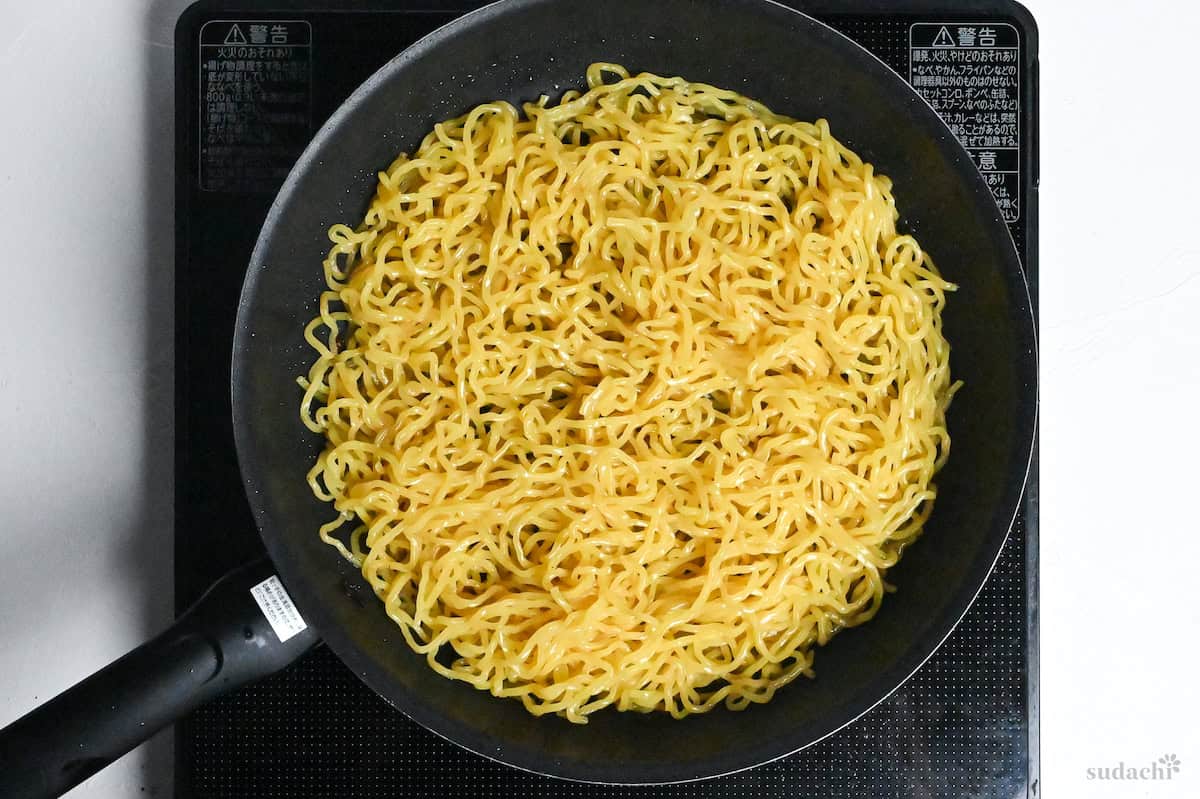
Pour in the prepared sauce, stirring constantly to ensure even distribution.
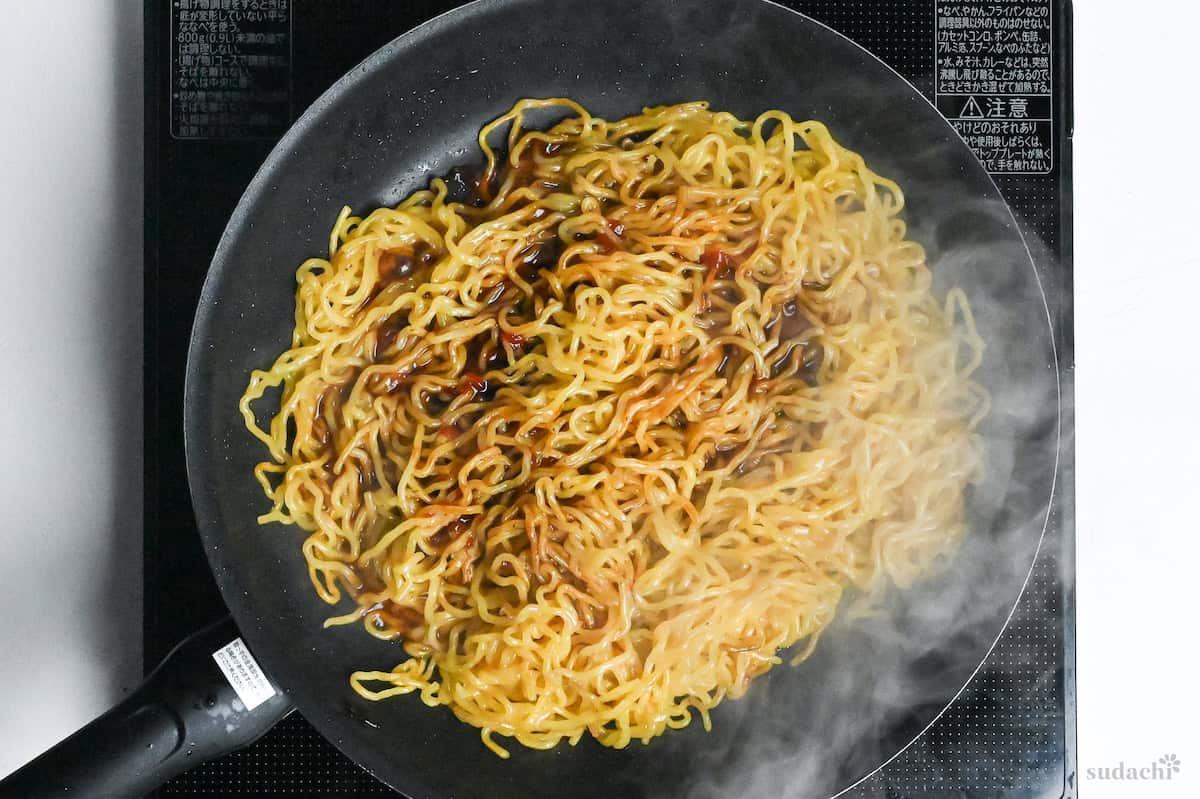
Add the reserved pork and onions with cabbage.
If you like your cabbage crunchy, tear it into rough pieces by hand and add it directly to the dish. If you prefer tender cabbage, just steam it in the microwave beforehand. This way, you can customize the texture to your liking!
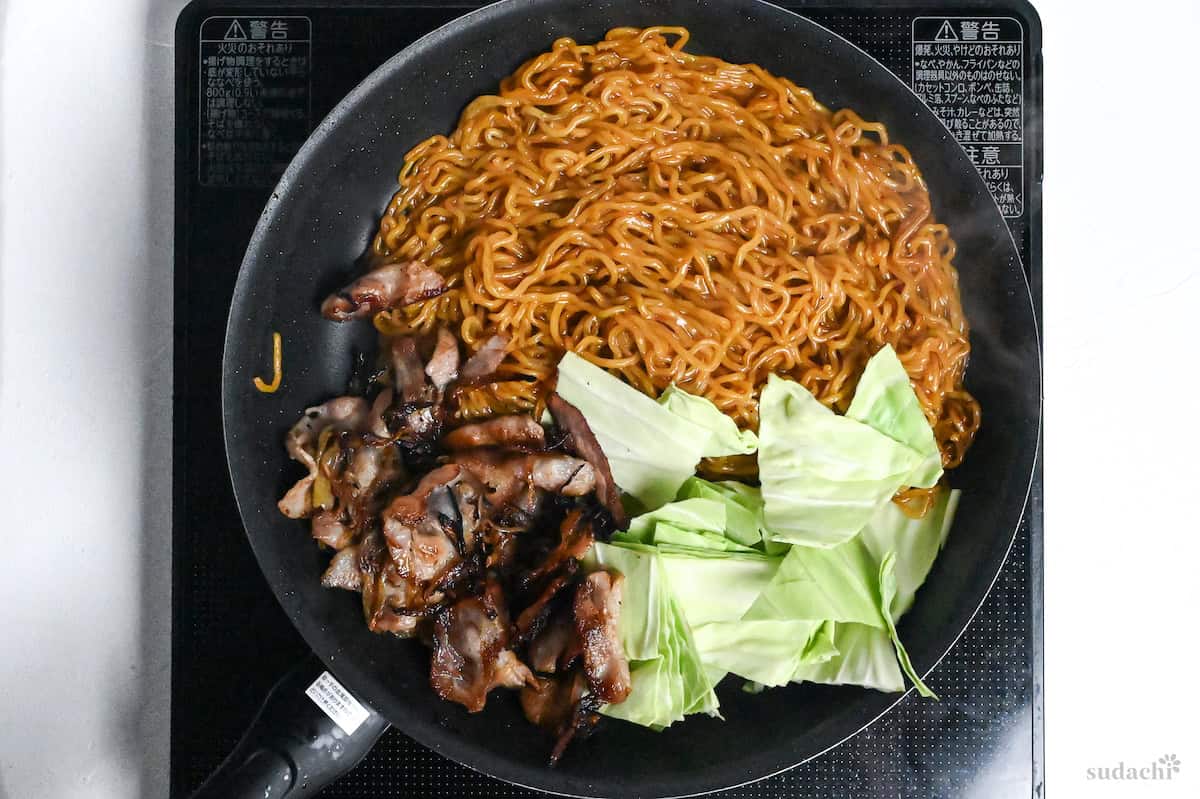
Continue stir-frying for 1-2 minutes, until the ingredients are well combined and the cabbage reaches your desired texture.
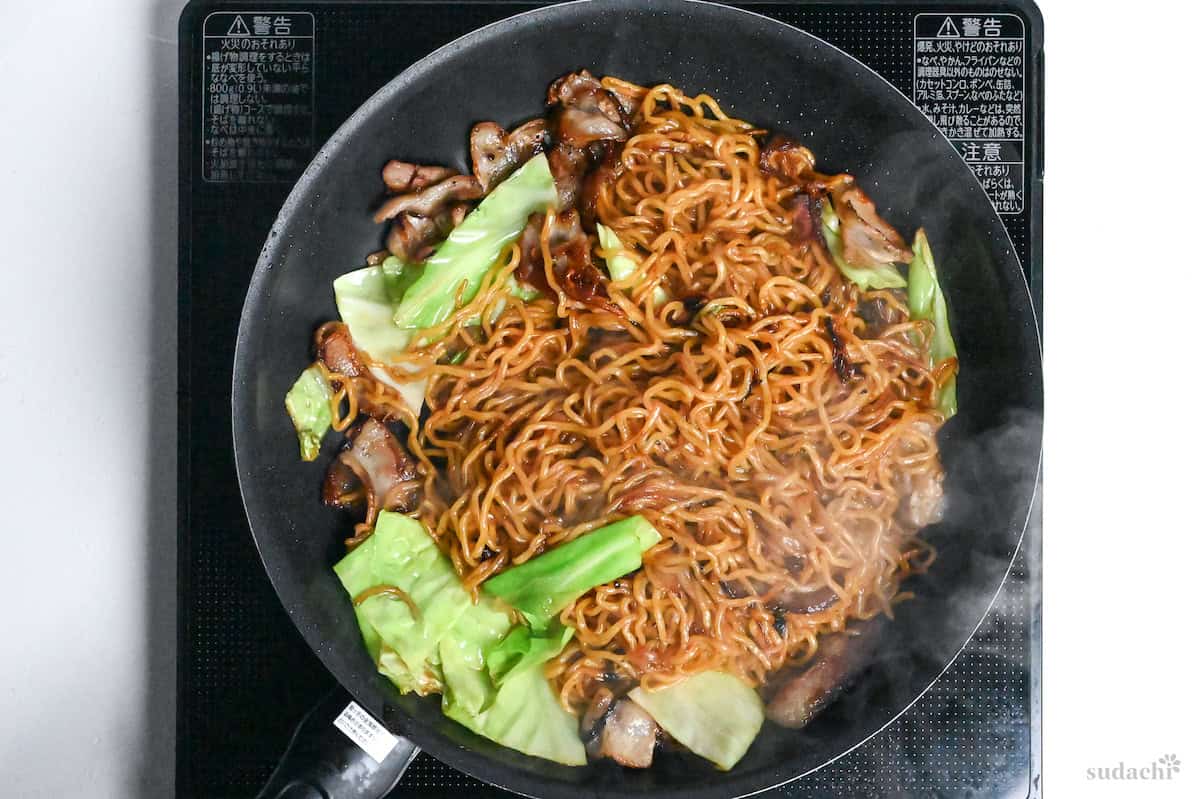
Transfer to serving plates and top with benishoga, dried bonito flakes, and aonori powder. Serve immediately while hot for the best texture and flavor.
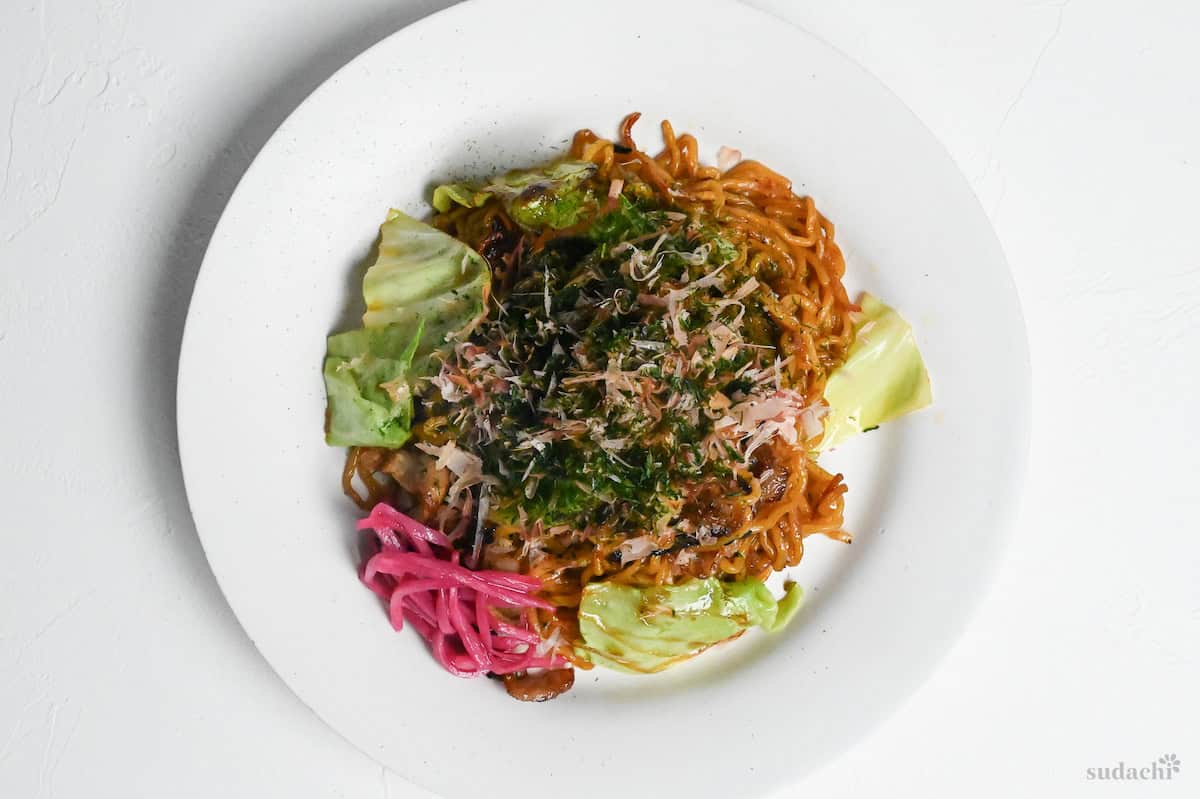
These three toppings can totally transform the whole dish! They add an incredible depth of flavor that makes a huge difference. So if you can get your hands on them, I highly recommend giving them a try. The impact on the final taste is truly worth it!
Jump to Full Recipe MeasurementsEssential Tips & Tricks
- Fry the noodles separately in oil – This is so important that it’s not just a tip, but one of the steps in my recipe! When you fry them, you get rid of some of the moisture, the oil makes the noodles a bit crispy, and that helps the sauce stick better. You end up with better flavor and texture, and a better yakisoba!
- Prepare dry noodles carefully – If you can’t find ready-to-cook or fresh noodles, dry noodles will work too. First, boil the noodles until they’re al dente, then rinse them to wash away the starch. Then, give them a good shake in a colander to get rid of any extra water, and toss on a bit of oil. Once you’ve done that, your noodles are good to go for frying, and you can move on with the rest of the recipe as usual.
- Cut the vegetables thin and uniform – This helps you cook them faster and more evenly.
- Maintain a high heat – This will make sure the ingredients cook quickly and don’t steam. Steam makes the yakisoba soggy.
- Pick your vegetables carefully – Be careful of vegetables with high water content since they can soak up moisture from the noodles, and before you know it, your dish is all soggy.
- Cook vegetables in order of firmness – This is advice for those who want to add additional vegetables. The best way to make sure everything is cooked right and ready at the same time is to add them in order of firmness.
- Don’t cook too long – Most vegetables in yakisoba should still have a bit of bite, so be careful not to overcook them. Make sure to use a high heat to cook them quickly, low heat and cooking them slowly will create steam and make the vegetables limp and soggy.
- Be generous with toppings – You’ve got to add plenty of red pickled ginger, aonori, and/or katusobushi (bonito flakes) if you want the dish to have that authentic Japanese flavor. It’ll also make the dish more vibrant and visually appealing.
With these simple tips in mind, you’re set for success every time you make Yakisoba.
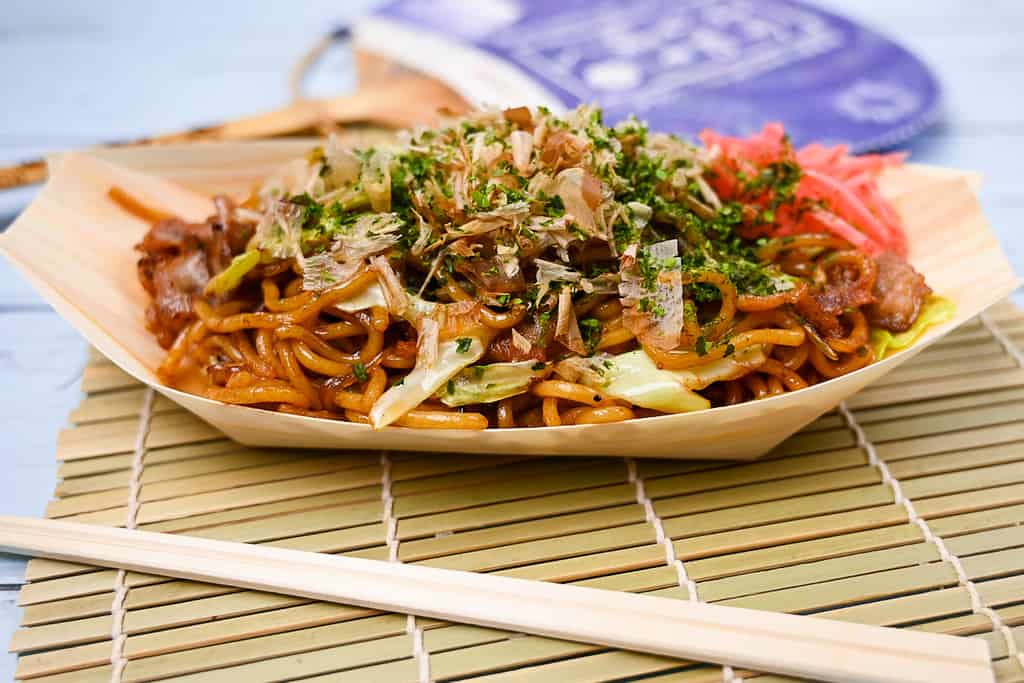
How to Store
It’s advised to store yakisoba in the refrigerator or freezer rather than at room temperature. When refrigerated, yakisoba can stay fresh for up to 2 days, and reheating it in a pan will yield the best flavor (although microwaving is also acceptable for convenience).
If you freeze it, spread each portion flatly before placing it in a freezer bag. Seal the bag securely to keep air out. Ideally, consume frozen yakisoba within two weeks for the best quality.
Serving Suggestions
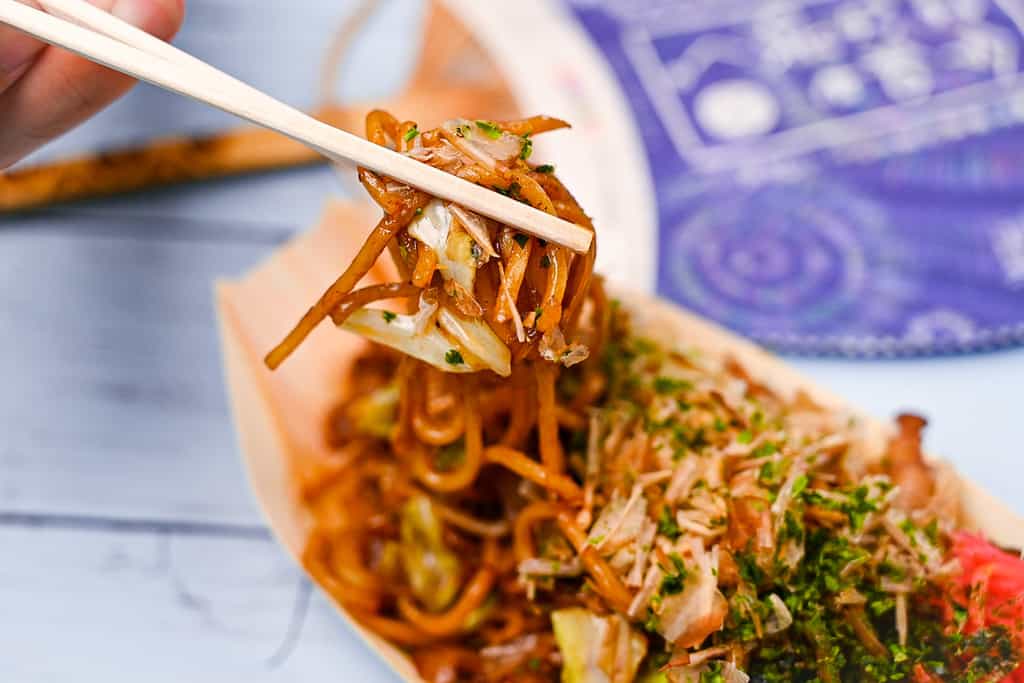
FAQ
Here are answers to frequently asked questions I have received across all platforms, including here, YouTube, and Pinterest. If you have any questions, feel free to send them to me anytime! It will be a big help for everyone in this community!
This is a typical dish that people would eat for lunch in Japan or a festival/event. It’s common to eat at home or in a bento (lunchbox), too.
In Japan, most people eat Yakisoba with chopsticks. Sometimes, it’s served in hotdog buns (Yakisoba pan), or wrapped in an omelette (Omusoba).
The ingredients are a little different, and Japanese Worcestershire sauce contains more fruits, so it’s a little sweeter. But overall, they taste quite similar and can be used interchangeably.
Originating from 1930s Tokyo, yakisoba’s straightforward outdoor preparation has made it a staple at events like festivals, sports days, and cherry blossom viewings, as well as in homes and casual eateries.
Instant yakisoba serves as a quick treat for many, and regional variations compete in the B-class gourmet (B級グルメ) category, offering delicious dishes made from budget-friendly ingredients.
You can substitute it with dry white wine, dry sherry, or kombu dashi. In a pinch, water will work too, though you might lose some depth of flavor.
While “nostalgic” Showa-era yakisoba relied heavily on Worcestershire sauce, modern yakisoba has evolved significantly since then. Today, there are over 50 varieties of yakisoba in Japan, and it has become a celebrated “B-grade gourmet” dish. This recipe uses less Worcestershire sauce to create a richer, more complex sauce that’s closer to what you’d find at modern B-grade gourmet food festivals. It’s a contemporary take that offers more depth and character than the simple Worcestershire-based versions.
For the best taste and texture, I recommend making and eating yakisoba fresh. The noodles tend to become dry and hard when stored, which can significantly affect the quality. I suggest making only what you plan to eat immediately to enjoy the dish at its best.
Recipe Update: January 2025
As mentioned at the beginning, I made a few enhancements to the original recipe in January 2025. If you want to see the original, you can still find it in my YouTube video!
I hope you enjoy this Yakisoba recipe! If you try it out, I’d really appreciate it if you could spare a moment to let me know what you thought by giving a review and star rating in the comments below. It’s also helpful to share any adjustments you made to the recipe with our other readers. Thank you!
More Street Food Recipes
- Crispy Karaage (Japanese Fried Chicken)
- Osaka Style Okonomiyaki
- Hiroshima Style Okonomiyaki
- Takoyaki (Fried Octopus Balls)
Hungry for more? Explore my street food recipe collection to find your next favorite dishes!
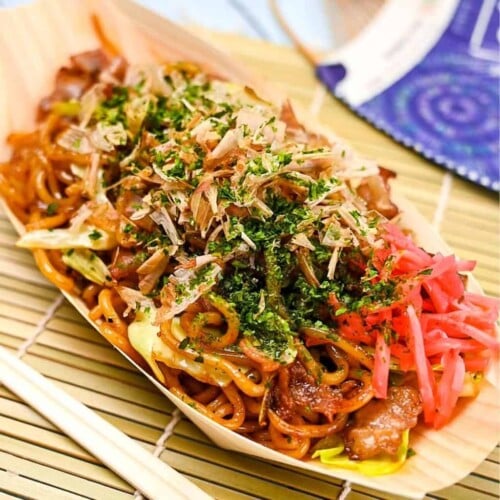
Authentic Yakisoba (Japanese Stir-fried Noodles)
Ingredients
Yakisoba
- 140 g thinly sliced pork belly leaner option: pork loin
- ¼ onion thinly sliced
- 1 pinch salt and pepper
- 50 g green cabbage roughly chopped
- 2 ptns ramen noodles
- 1 tbsp cooking oil
- red pickled ginger (benishoga) optional topping
- bonito flakes (katsuobushi) optional topping
- aonori (dried green seaweed powder) optional topping
Yakisoba Sauce
- 1 tbsp Japanese soy sauce (koikuchi shoyu)
- 1 tbsp oyster sauce
- ½ tbsp Worcestershire sauce
- ½ tbsp sake or white wine
- 1 tsp tomato ketchup
- 1 tsp toasted sesame oil
- ½ tsp sugar
- ¼ tsp curry powder
- 1 pinch ground black pepper
My recommended brands of ingredients and seasonings can be found in my Japanese pantry guide.
Can’t find certain Japanese ingredients? See my substitution guide here.
Instructions
- Start heating a large non-stick pan or wok on medium and add a drizzle of cooking oil. Once hot, add 140 g thinly sliced pork belly, ¼ onion and season with 1 pinch salt and pepper. Fry until the pork is crispy and the fat has rendered out, and the onions are soft and dark. If you need to boil your noodles, start heating a pot of water ready. (Tip: if using extra vegetables that need sufficient cooking, add them here too.)

- If you are using dried or fresh noodles, boil them less than the instructed time. A good rule of thumb is to subtract 10 seconds from every minute of the recommended cooking time. Drain them, rinse them with cold water and shake thoroughly to remove as much moisture as possible.

- Transfer the cooked pork and onions to a plate. We will reuse the pan to cook the noodles in the rendered pork fat. (Note: If the pan is too oily, feel free to wipe out the excess with kitchen paper.)

- Place 2 ptns ramen noodles in a bowl and add 1 tbsp cooking oil. Mix until the noodles are evenly coated in the oil.

- Reheat the pan on medium-high, add the noodles and cook until both sides are slightly browned and crispy but not burnt.

- While the noodles crisp up, make the sauce by adding 1 tbsp Japanese soy sauce (koikuchi shoyu), 1 tbsp oyster sauce, ½ tbsp Worcestershire sauce, ½ tbsp sake, 1 tsp tomato ketchup, 1 tsp toasted sesame oil, ½ tsp sugar, ¼ tsp curry powder and 1 pinch ground black pepper to a small bowl and mix well.

- Once the noodles are slightly crispy, pour the sauce over them and mix until evenly coated.

- Add the pork and onion back in, along with 50 g green cabbage (roughly chopped).

- Stir-fry for 1-2 minutes or until everything is warmed through.

- Dish up and sprinkle generously with red pickled ginger (benishoga), bonito flakes (katsuobushi) and aonori (dried green seaweed powder). Enjoy!

Video
Notes
- Use a non-stick frying pan to prevent noodles from sticking.
- Skip boiling and oiling if using pre-steamed yakisoba noodles.
- Customize vegetables to your preference, but avoid using too many water-rich ones to prevent sogginess.
- If you want to make this yakisoba from fresh noodles, I’d suggest making your own ramen noodles or using my spaghetti ramen hack. I wouldn’t recommend using instant noodles.
- Add extra cooking oil or lard to compensate when using leaner cuts or different proteins instead of pork belly.
- Store in refrigerator (up to 2 days) or freezer (up to 2 weeks). For freezing, spread portions flat in freezer bags with air removed. Best reheated in pan, though microwave works too.
- Serving ideas: Chicken karaage, Japanese potato salad, Hiyayakko, Japanese egg drop soup.
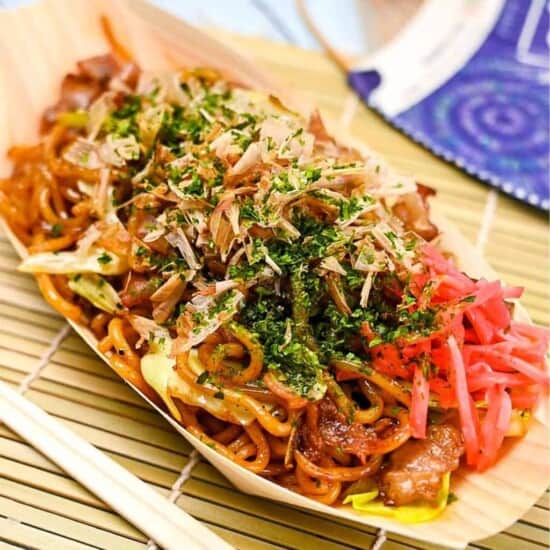






We tried this recipe last night because it has been a hot minute since my boyfriend and I have had a good yakisoba and I have to say, everything about it was fantastic! For sure a new favorite in our home. Thank you for sharing this!
Hi Ashley. Thank you for trying my recipe and giving such kind feedback, I’m happy you enjoyed it!
The components of this recipe are spot on! As suggested I tweaked the quantity and added togarashi in addition to the black pepper.
Thank you for the recipes!
(Can you recommend any suppliers that ship authentic Japanese food products to Athens,Greece?)
Much appreciated!
Hi Nicholas,
Thank you so much, I’m glad you enjoyed the recipe!
It’s a little hard to say because I live in Japan so I don’t really keep an eye out for places that ship worldwide, but when I lived in England I found http://www.japancentre.com a great place for Japanese ingredients and they definitely ship to Greece. Another one is dokodemo.world which is based in Japan, they ship to Greece but it might take longer. Hope that helps!
Interesting. I am originally from Tokyo, but I have never known katsuobushi as topping. I have heard of yakisoba recipes using katsuobushi when stir frying though. I have to try it and see what I think. Usually just beni shoga and aonori.
Some people don’t add katsuobushi but it’s a popular addition for home cooks. It’s not essential but I like adding katsuobushi personally 🙂
as a private chef, my client always asks me to pick up ramen noodles. but since I saw a Yakisoba noodles that comes with a pack of seasoning with it from the asian store I figured I search for easy sauce from scratch and found your website. since then no more ramen noodles and I used leftover veggies in the fridge which works just fine. some people only know sushi when I say Japanese cuisine or maybe teriyaki not knowing there’s other recipes that they (americans) don’t know about. thanks to your site I have been learning more recipes and enjoying them and not just at work but my family and friends too. thanks again..
“never stop learning’
Hi Edwin,
Thank you so much for your comment and for sharing your experiences! I’m honored that you enjoy exploring my website. I’ll continue to post more authentic Japanese recipes!
Yuto
what could I use instead of the alcohol do make the sauce
Hi Sultan,
Thank you for the question. Seeing as it’s just a small amount, you can simply replace it with water!
Yuto
Greetings. I hope this finds you well and thank you for sharing your recipes with the world.
I unfortunately do not have access to pre-boiled noodles, but can easy come by dried. I read your notes on how to prepare them, but was curious if the same measurements applied.
Do you recommend 200 grams of dried noodles, or a lesser weight do to their growth when cooking. Any advice would be wildly appreciated.
Thank you so much for your time.
Hi Elizabeth,
Thank you for your question! When using dried noodles for yakisoba, a good starting measurement is approximately 80g per person (before cooking). So only a little bit less than pre-boiled! I hope this helps with your cooking! Feel free to reach out if you have any more questions.
Yuto
You are the boss, applesauce! I truly appreciate your time and help.
I can’t wait to give this a try tomorrow. Many, many thanks again.
Please, take care and stay awesome!
Elizabeth
Thank you, Elizabeth! I hope you’ll enjoy it!
Yuto
Very tasty! I did not have sake nor white wine open so I used shaohsing wine (which I know is Chinese but it’s what I had) – the flavor turned out very well. Having travelled in Japan this past summer we were missing the authentic flavor of yakisoba. I think most Americanized recipes are missing the dash of curry powder and the Worcestershire sauce.
Hi Stacie,
Thank you so much for trying the recipe and sharing your experience! I’m so happy that it satisfied your craving for authentic yakisoba after your travel! 🙂
Yuto
Very tasty, though I think I fried the noodles for too long. I was waiting for them to go crispy, but they kinda went chewy instead. Still, loved it and will be making it again.
Forgive the photo. I’m not the best at presentation 🙂
Hi Ralph,
Thank you for trying the recipe and sharing your feedback! You’re right about the noodles – the frying time can be tricky to get right! I’m so glad you enjoyed it and plan to make it again! And thanks for sharing your photo – it looks delicious!
Yuto
Delicious!
Thank you, Lilian! 🙂
I just made this and even got Japanese Worcestershire sauce. The sauce is so balanced. I did the veggies in the recipe and added mushrooms and red bell pepper. I added some liquid smoke to emulate the wok hei flavor. Amazing.
Hi Kimberly,
Thank you so much for trying this recipe! I’m happy to hear you enjoyed the sauce! I appreciate you sharing your creative adaptations and I love them all! 🙂
Yuto
I cook a lot of Asian food but never tried yakisoba, first try was pretty awesome! I made as-is with added mushrooms, family inhaled it. Great instructions and added to the rotation – thank you!
Hi Jon,
Thank you so much for giving it a try! I’m really glad to hear you and your family enjoyed it
Yuto
I loved these noodles at Johnny noodle king in Detroit Michigan’s and so happy to get this recipe so I can make at home. Thank you for sharing.
Thank you so much for your kind words, Susan! I’m happy that you enjoyed it! 🙂
Yuto
I looks like a great recipe! I will try it soon. Sorry asking a foolish question, but what does the “2 ptns ramen noodles” mean? PTNS? Thank you!
Hi Julio,
Thank you! And not a foolish question at all! “2 ptns” means 2 portions of ramen noodles here! 😊
Yuto